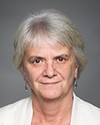Yes, we have a number of models. The one that we focus on, particularly with regard to humanitarian assistance, is for women to lead in emergencies.
When we look at emergency response around the world, we see it's traditionally planned by the people who are locally in power. In a place like South Sudan, those traditional leaders are primarily men, so our focus is on trying to get conflict-affected women involved in the planning and delivery of humanitarian assistance. We believe that if you're involved from the start in the planning, in playing a leadership role in that food distribution, in the delivery of sex and reproductive health services, those services are going to better meet the needs of women and girls.
At the same time, we're investing in local women leaders, which is then going to put them in a different position, one where they are able to influence local traditional powers. We're doing that in a number of countries: South Sudan, Bangladesh, DRC. That's our goal there.


